No, I’m not a believer, but with Easter on the way, I thought it proper to publish my list of Seoul’s most beautiful churches.

You’d be hard pressed to find a visitor to Korea that hasn’t noticed the red neon crosses that illuminate the night sky in Seoul.
Although Christianity didn’t settle here until the late 18th century (with a very bloody century of persecutions to follow), Koreans quickly made up for lost time.
In fact, about one-quarter of Koreans identify as Catholic or Protestant, and they comprise the world’s second largest cohort of overseas Christian missionaries.
Two more fun facts:
1) Seoul’s Yoido Full Gospel Church boasts the world’s largest single congregation, with a reported 800,000 members!
2) Korea has the third most saints in the Catholic world (103). When Pope Francis visits Korea on August 15, 2014, 124 more Korean martyrs will join their esteemed ranks.
With such devoted adherents, it’s not surprising that Seoul boasts several wonderful houses of worship. Without further delay, my list of Seoul’s most beautiful churches.
Chungdong First Methodist Church (정동교회)
Seoul’s historic Jeong-dong neighborhood is a great place for self-guided walking tours, thanks to the wealth of pre-colonial and colonial buildings. Among them, the Chungdong First Methodist Church is the oldest.
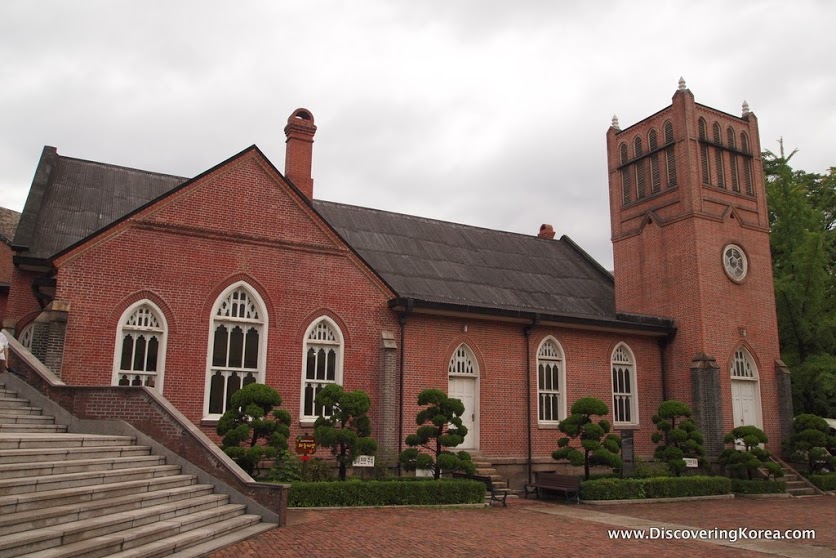
Built in 1897 by the American missionary Henry Appenzeller, the red brick, single-story building (with a three-story bell tower) has a truss-ceiling frame built over wood columns.
While the exterior follows a typical country Gothic style that was popular during the Victorian era, if you take a look inside, you’ll see something interesting – a flat mansard.
| Open: | Inquire for services info. |
| Admission Price: | Free |
| Address: | Seoul Jung-gu Jeong-dong 34 |
| Directions: | City Hall Station (#132/#201) on Lines 1 & 2, Exit 1 |
| Phone: | 02-753-0001 |
| Website: | Official Site |
Jangchung Church (장충교회)
Lest you think I find only find old buildings beautiful, behold! A striking modern addition to Seoul’s houses of worship!
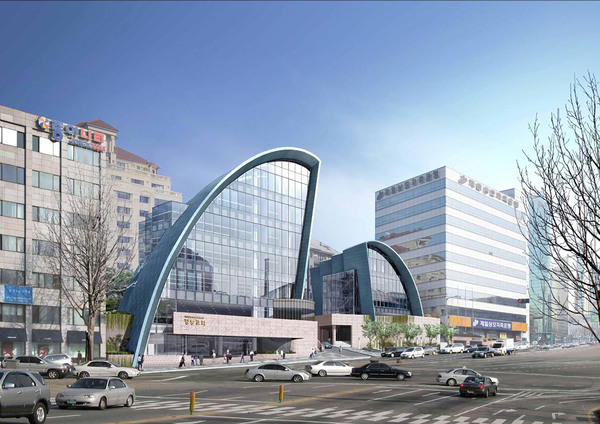
Built in a neighborhood best known for restaurants serving pigs’ feet, Jangchung Church was completed in 2011 and designed by Nam Il Joe and Hakchul E. Kim.
The church, which straddles an alley between two parcels, resembles glass dorsal fins moving in opposite directions. While the larger fin is tilted 10 degrees, the smaller tilts 15.
Both fins’ are covered in a multi-layered turquoise shell that resembles armor. In a nod to its superior design, Jangchung Church won 1st Place in the 2012 Korea Church Architecture Awards.
| Open: | Inquire for services info. |
| Admission Price: | Free |
| Address: | Seoul Jung-gu Dongho-ro 250 (Jangchung-dong 1(il)-ga) |
| Directions: | Dongdaemun Station (Line 3), Exits 3 & 4 |
| Phone: | 02-2279-9331 |
| Website: | Official Site |
Jeoldusan Martyrs’ Shrine (절두산순교성지)
There’s an attractive two-tiered chapel that sits on a bluff alongside the Hangang river.
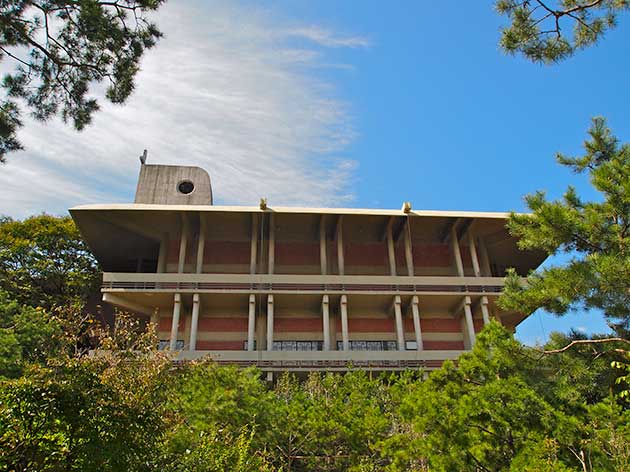
Called “Jeoldusan” or “Beheading Mountain,” it’s where several dozen Roman Catholic martyrs were killed as part of the Byeonin Persecution of 1866-1873, when 8,000 believers were martyred across Korea.
In 1956, the site was purchased and a chapel was designed by Yi Hui-tae, with several notable elements – the central cross, marble altar, tabernacle and bell tower decorated by the image of a martyr set in relief – were sculpted by Kim Se-jung.
Beneath the chapel is the Reliquary, where the relics of 28 martyrs are enshrined in granite. The Jeoldusan Martyrs’ Shrine also includes a museum that contains 3,500 historical artifacts.
| Open: | 09:30-17:00, Closed Mondays |
| Admission Price: | Free |
| Address: | Seoul Mapo-gu Tojeong-ro 6 (Hapjeong-dong) |
| Directions: | Hapjeong Station (Lines 2 & 6), Exit 7 |
| Phone: | 02-3142-4434 |
| Website: | Official Site |
Kyungdong Presbyterian Church (경동교회)
In our time of stark, glass and concrete buildings, a windowless brick fortress is especially refreshing!
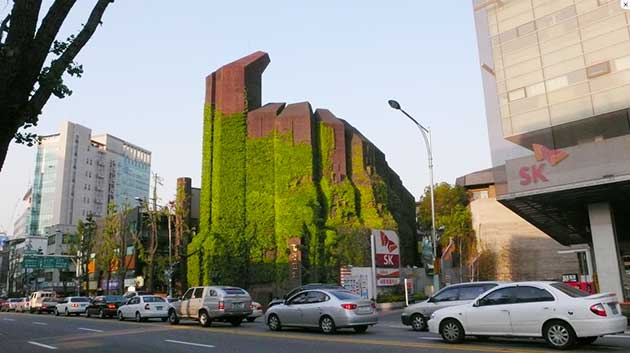
Of course, it doesn’t hurt if it’s designed by the venerable Kim Swoo Geun, one of Korea’s most celebrated post-WWII architects. Jangchung-dong’s Kyungdong Presbyterian Church is one of his best works, its unusual shape inspired by hands clasped in prayer.
The church features other meaningful design elements, such as the long staircase that leads to the main entrance in the back – a transitional place to prepare for worship.
The breathtaking interior is nearly windowless, save a skylight that shines down on the main chapel’s cross.
| Open: | Inquire for services info |
| Admission Price: | Free |
| Address: | Seoul Jung-gu Jangchungdan-ro 204 |
| Directions: | Dongdaemun History & Culture Park Station (#205/#422/#536) on Lines 2, 4 & 5, Exit 4 |
| Phone: | 02-2274-0161 x3 |
| Website: | Official Site |
Myeongdong Cathedral (명동대성당)
Located atop a hill in Seoul’s shopping mecca of Myeong-dong, Myeongdong Cathedral is the better-known name for what is officially the Cathedral Church of the Virgin Mary of the Immaculate Conception.
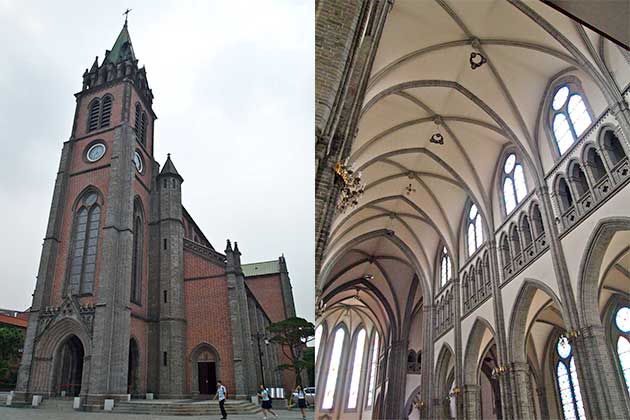
As the main cathedral of Korea’s Roman Catholic community, it’s appropriately grand. Constructed (and paid for) by French Catholics, King Gojong attended the cathedral’s cornerstone ceremony in 1892, despite having tried to prevent its construction.
Seven years later, the church, built in a traditional Gothic style with a high, vaulted nave and dual aisles creating all in the shape of a cross, was complete.
The church’s 47-meter tall steeple dwarfed much of the city when it was first built. Several decades later, it played an important role during Korea’s democracy movement as a refuge for activists.
The departed former Archbishop of Seoul, Cardinal Kim Sou-hwan, was widely revered for his courageous opposition to the policies of South Korea’s military dictators.
| Open: | Inquire for services info |
| Admission Price: | Free |
| Address: | Seoul Jung-gu Myeongdong-gil 74 (Myeong-dong 2(i)-ga) |
| Directions: | Euljiro 1(il)-ga Station (#202) on Line 2, Exit 5 |
| Phone: | 02-774-1784 |
| Website: | Official Site |
Namdaemoon Presbyterian Church (남대문교회)
Situated on high ground facing Seoul Station, Namdaemoon Presbyterian Church was completed in 1969, although it looks considerably older to my untrained eye.
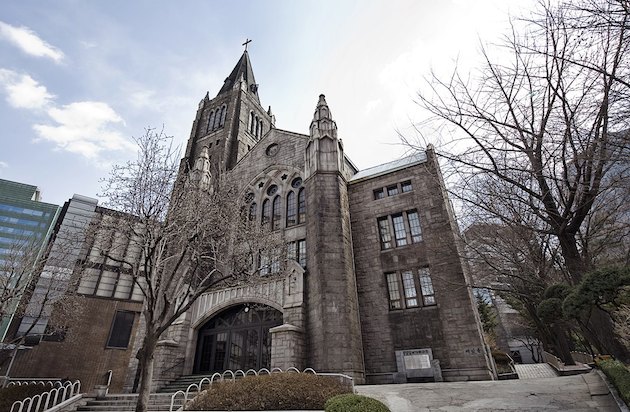
Then again, the church’s heritage is indeed more ancient, since the original building was completed in 1885 as a hospital, before it was converted to a house of worship in the early 1900s, before falling victim to the Korean War.
The existing church was designed by Park Dong-jin in his favored Gothic style complete with Tudor arches and a liberal use of granite.
Visitors can enjoy the church’s attractive courtyard, which it shares with the big black behemoth better known as the Millennium Seoul Hilton hotel.x
| Open: | Inquire for services info |
| Admission Price: | Free |
| Address: | Seoul Jung-gu Toegye-ro 6 (Namdaemun-ro 5(o)-ga 544 |
| Directions: | Seoul Station (#133/#426/#P313/#A01) on Lines 1, 4, Gyeongui and AREX, Exit 8 |
| Phone: | 02-753-6343 |
| Website: | Official Site |
Seoul Anglican Cathedral (대한성공회유지재단)
Although Catholicism took root in Korea in 1784, the first Anglican mission didn’t arrive in Korea until 101 years later.
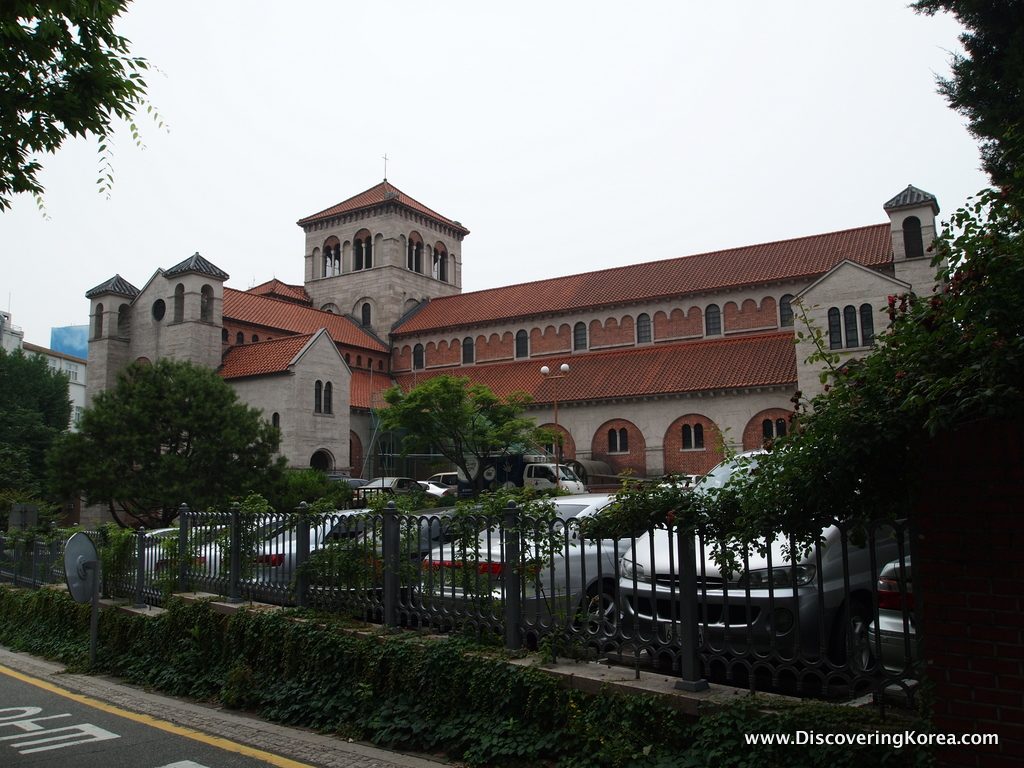
Despite the delay, Seoul Anglican Cathedral is undoubtedly among Seoul’s most beautiful churches.
The Romanesque-style building was designed by a British architect and sort-of completed in 1926, but due to money woes it wasn’t finished until 1996, after the building’s original plans were discovered in a rural church in England!
The gorgeous, fusion-inspired result is red bricks and granite with Korean-style roof tiles. My favorite part of the church is the way the blue, pink and purple glass windows filter the sunlight.
| Open: | Sundays 09:30 (English Service) |
| Admission Price: | Free |
| Address: | Seoul Jung-gu Jeong-dong 3 |
| Directions: | City Hall Station (#201/#132) on Lines 1 & 2, Exit 3 |
| Phone: | 02-9462-9730 |
| Website: | Official Site |
Wonhyoro Catholic Church and Yongsan Seminary (용산신학교와 원효로성당)
In 1887, just three years after the Korean government allowed foreign settlement in Seoul’s Yongsan area, the Catholic Church relocated its seminary there.
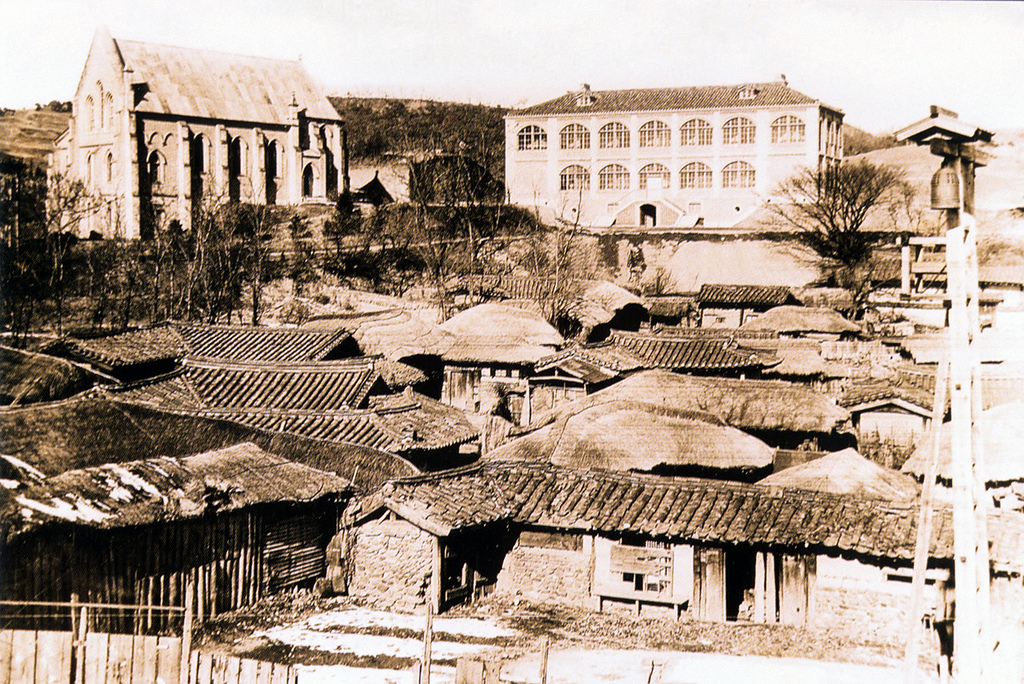
Five years later, a fetching Georgian-ish structure designed by Father Eugene Coste of France was built. Next to the Seminary was (and is) a lovely church that’s surprisingly un-heralded.
Located atop a hill on the campus of the Sacred Heart Girls High School, the Gothic chapel, Wonhyoro Catholic Church, was completed in 1902. Inside, the mix of wood, brick and stained glass is truly lovely.
| Open: | Inquire for services info |
| Admission Price: | Free |
| Address: | Seoul Yongsan-gu Wonhyo-ro 4(sa)-ga 1 |
| Directions: | Hyochang Park Station (#627) on Line 6, Exit 3 |
| Phone: | 02-9462-9730 |
| Website: |
Youngnak Presbyterian Church (영락교회)
And finally, another Myeong-dong house of worship is the Youngnak or “Everlasting Joy” Presbyterian Church.
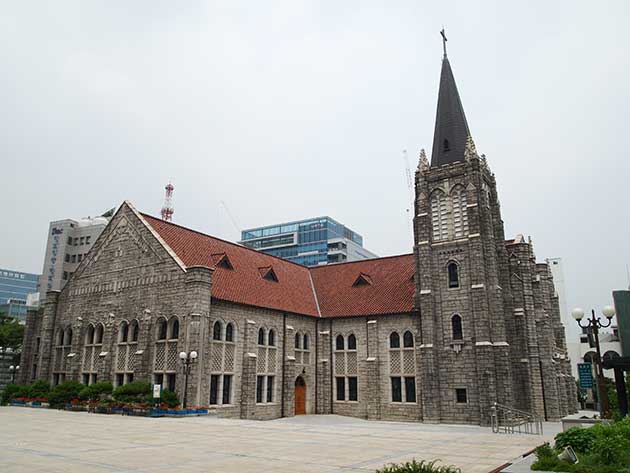
Founded in 1945, it was inaugurated by refugees from Soviet-occupied, post-colonial Korea who sought religious freedom in what would become South Korea.
After quickly outgrowing its original walls, the expanded church held mass just weeks before the official start of the Korean War, a time when it was occupied by North Korean troops.
The Church was designed by the Korean architect, Park Dong-jin, whose works – including Namdaemoon Presbyterian Church – are notable for their superior masonry and Gothic Revivalism style.
Today, the church’s 60,000-strong congregation is one of the world’s largest Presbyterian flocks.
| Open: | Inquire for services info |
| Admission Price: | Free |
| Address: | Seoul Jung-gu Supo-ro 33 |
| Directions: | Myeongdong Station (#424) on Line 4, Exit 10 |
| Phone: | 02-2280-0114 |
| Website: | Official Site |
There you have it, my list of Seoul’s most beautiful churches. Your thoughts?
Did I omit your favorite or include somewhere unworthy? Let me know! Until then, to all my Christian readers, a very Happy Easter!
About Matt Kelley
Matt Kelly is native of the US Pacific Northwest and is half-Korean by ethnicity. He lived in Korea for five years and has written hundreds of travel guides for Wallpaper, TimeOut, the Boston Globe and Seoul Magazine and was a host for several different variety shows on Korean radio and television.
